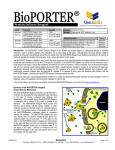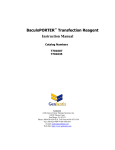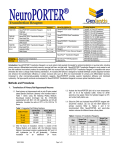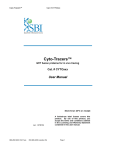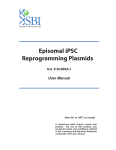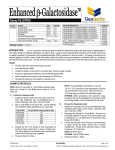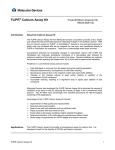Download BioPORTER Reagent
Transcript
BioPORTER Reagent QuikEase Single-Use Tubes Instruction Manual Catalog Numbers: BP502424, BP509696 Genlantis A Division of Gene Therapy Systems, Inc. 10190 Telesis Court San Diego, CA 92121 Phone: 888-428-0558 (US. Toll-Free) z 858-457-1919 Fax: 858-623-9494 z 858-558-3617 E-mail: [email protected] Web Site: http://www.genlantis.com Purchaser Notification Limited License The purchase price paid for the BioPORTER Protein Transfection Reagent by end users grants them a non-transferable, non-exclusive license to use the reagent and its components (as listed in the Contents section). This reagent is intended for internal research only by the purchaser. Such use is limited to the delivery or transfection of proteins into cells as described in the product manual. Furthermore, research only use means that this kit and all of its contents are excluded, without limitation, from resale, repackaging, or use for the making or selling of any commercial product or service without the written approval of Genlantis, a division of Gene Therapy Systems, Inc (“Genlantis”). Separate licenses are available from Genlantis for the express purpose of non-research use or applications of the BioPORTER reagent. To inquire about such licenses, or to obtain permission to transfer or use the enclosed material, contact the Director of Licensing at Genlantis. There is a Patent Pending on the BioPORTER reagent. Purchasers may terminate this License at any time by returning all BioPORTER reagent and/or kit material and documentation to Genlantis, or by destroying all BioPORTER reagent or kit components. Purchasers are advised to contact Genlantis with the notification that a BioPORTER reagent is being returned in order to obtain a refund and/or to expressly terminate a research only license granted through the purchase of the kit(s). This document covers in full the terms of the BioPORTER research only license, and does not grant any other express or implied license. The laws of the State of California shall govern the interpretation and enforcement of the terms of this License. Product Use Limitations The BioPORTER reagent and all of its components are developed, designed, intended, and sold for research use only. They are not to be used for human diagnostic or included/used in any drug intended for human use. All care and attention should be exercised in the handling of the kit components by following appropriate research lab practices. For more information, or for any comments on the terms and conditions of this License, please contact: Director of Licensing Genlantis, a division of Gene Therapy Systems, Inc. 10190 Telesis Court, San Diego, CA 92121. Phone: Fax: Email: 888-428-0558 (U.S. Toll-free) or 858-457-1919 858-623-9494 or 858-558-3617 [email protected] BioPORTER QuikEase Genlantis, a division of Gene Therapy Systems, Inc. Ph: 888-428-0558 z www.genlantis.com Rev. 03152006 2 TABLE OF CONTENTS Page OVERVIEW Purchaser Notification ...............................................................................................................2 Kit Contents and Ordering Information .....................................................................................4 Stability and Storage ..................................................................................................................4 Introduction................................................................................................................................5 Summary of the BioPORTER Protein Delivery Mechanism...................................................6 METHODS AND PROCEDURES General Protocol Preparation of BioPORTER/Protein complexes ...............................................................7 Example Protocols Delivery of fluorescent-antibody, β-galactosidase or dextran sulfate .................................9 Delivery of granzyme B and caspase 3 into Jurkat & Ki-Ras-267 β1 cells ......................10 APPENDIX Protocol for Optimization ........................................................................................................12 Quality Control ........................................................................................................................13 Troubleshooting Guide ............................................................................................................14 Quick reference Protocol for Experienced Users.....................................................................15 Record-keeping Grid................................................................................................................16 BioPORTER QuikEase Genlantis, a division of Gene Therapy Systems, Inc. Ph: 888-428-0558 z www.genlantis.com Rev. 03152006 3 OVERVIEW Kit Contents and Ordering Information The BioPORTER reagent is the latest innovation in macromolecule delivery technology. It is a unique lipid-based formulation that allows the delivery of proteins, peptides or other bioactive ® molecules into a broad range of cell types. The BioPORTER QuikEase kits contain 24 or 96 individual tubes of the BioPORTER reagent in a convenient, ready-to-use, single reaction format. Each tube contains sufficient material of the lyophilized BioPORTER reagent to perform 1 reaction in a 6-well plate (or 35mm dish) or 4 reactions in a 24-well plate (or 16mm wells). The BioPORTER reagent is ready to use and only needs to be formulated with the protein solution (or other molecule of interest) to be delivered according to section 1.1 on page 7. Catalog Number Number of Tubes Description Size or Aliquot BP502424 24 BioPORTER QuikEase Reagent, lyophilized β-galactosidase control protein FITC-antibody control protein (fluorescein-labeled goat IgG) 1 reaction per tube 1 1 96 BP509696 BioPORTER QuikEase Reagent, lyophilized β-galactosidase control protein FITC-antibody control protein (fluorescein-labeled goat IgG) 1 1 10 µg at 100 µg/ml 10 µg at 100 µg/ml 1 reaction per tube 10 µg at 100 µg/ml 10 µg at 100 µg/ml Use the contents of the table above to determine the appropriate catalog number for your needs. You can order the products above by contacting us at: Gene Therapy Systems, Inc. 10190 Telesis Court San Diego, CA 92121 Phone: 888-428-0558 (U.S. Toll-free) or 858-457-1919 Fax: 858-623-9494 or 858-558-3617 E-mail: [email protected] Web Site: http://www.genlantis.com Stability and Storage The BioPORTER reagent QuikEase tubes are shipped frozen. Upon receipt and for long-term use, store all QuikEase tubes or kits at –20o C. The BioPORTER reagent is stable for at least 1 year at the recommended storage temperature. BioPORTER QuikEase Genlantis, a division of Gene Therapy Systems, Inc. Ph: 888-428-0558 z www.genlantis.com Rev. 03152006 4 Introduction Congratulations on your purchase of the BioPORTER reagent QuikEase kit. The BioPORTER reagent is a new, versatile and efficient reagent for intracellular delivery of bioactive molecules, such as proteins, peptides or antibodies, into a broad range of cell types. Although there are many transfection reagents available to introduce transcriptionally active DNA into viable cells, approaches to deliver functional peptides and proteins into living cells are limited. For this reason, Gene Therapy Systems, Inc. has developed a different protein delivery approach using a unique lipid-based carrier system. The resulting BioPORTER is a novel reagent that contains a proprietary reactive lipid mixed with other components. The BioPORTER reagent is easy to use and more economical than both microinjection and electroporation for delivering biologically active proteins into living cells. The specific formulation of BioPORTER can deliver various molecules over a broad range of cell types in serum-free conditions. Molecule delivery is fast and reaches optimum levels after 4 hours of incubation. Various molecules such as fluorescent-antibody, high and low molecular weight dextran sulfate, phycoerythrin-BSA, β-galactosidase, caspase 3, caspase 8 and granzyme B have been successfully delivered into the cytoplasm of a variety of different adherent and suspension cells with the BioPORTER reagent. Furthermore, apoptotic proteins like granzyme B, caspase 3 or caspase 8 that were delivered into cells remained functional and drove cells into apoptosis. With BioPORTER you can make your macromolecules directly available for a variety of studies like intercellular signaling, cell cycle regulation, control of apoptosis, study of oncogenesis, and transcription regulation to name a few. The BioPORTER protein transfection reagent has been extensively tested to verified its effectiveness in delivering active molecules into a wide variety of cells (Table 1). The new QuikEase kits that contain single-use tubes of the BioPORTER reagent make it a more convenient tool for functional genomics or proteomics. With the efficiency of the BioPORTER reagent and the convenience of QuikEase format, you get the following benefits: • • • • • • • • BioPORTER pre-coated tubes for significantly reduced reagent preparation time Single reaction size for greater speed, accuracy, and format flexibility. Streamlined protocol to minimize contamination Reagent is effective in multiple cell types No cytotoxicity Fast transduction of macromolecules 3 to 4 hours post delivery Reagent that does not rely on covalent bonds Extended stability with long shelf life at -20o C. Table 1 - Cell Types Successfully Tested with BioPORTER HeLa-S3 293 NIH 3T3 B16-F0 BioPORTER QuikEase Jurkat Ki-Ras 267 β1 COS 7 K562 HeLa HepG2 P19 MDCK Genlantis, a division of Gene Therapy Systems, Inc. Ph: 888-428-0558 z www.genlantis.com BHK-21 CHO-K1 CV-1 COS-1 Rev. 03152006 5 Summary of the BioPORTER Protein Delivery Mechanism The dried BioPORTER reagent is directly formulated with a solution of the protein or peptide to be delivered. The BioPORTER reagent reacts quickly and interacts non-covalently with the protein, peptide or other molecules creating a protective vehicle for immediate delivery into cells. The hydrated mixture is then added onto cells and the BioPORTER/protein complexes attach to negatively charged cell surfaces. The BioPORTER reagent can then fuse directly with the plasma membrane and deliver the captured protein into cells (see 1 in Figure 1), or the BioPORTER/protein complexes are endocytosed and then fuse with endosomes releasing the BioPORTER-captured proteins into the cytoplasm (see 2 in Figure 1). Delivery of molecules with the BioPORTER reagent is very easy and requires only 4 hours of incubation in serum free condition with the target cells. Figure 1 – Diagram Depicting Protein Delivery into Cells by BioPORTER Reagent Protein Cell Membrane (Lipid bilayer) Nucleus 1 BioPORTER/Protein Complexes 2 Endosome BioPORTER QuikEase Genlantis, a division of Gene Therapy Systems, Inc. Ph: 888-428-0558 z www.genlantis.com Rev. 03152006 6 METHODS AND PROCEDURES 1. General Protocol NOTE The conditions that follow are recommended only as starting guidelines. For best performance of the BioPORTER reagent, we recommend that you optimize component concentration, cell number, time of incubation, and protein hydration buffers. Because optimum conditions are cell type- and assay-dependent, we are providing you with optimization guidelines in the Appendix section on page 12. Table 2 - Suggested number of reactions for each QuikEase tube of BioPORTER Tissue Culture Dish 96-well 24-well 12-well 6-well Number of reactions/tube 10 4 2 1 Each BioPORTER reagent QuikEase tube was designed for one single use per well in a 6well plate. If other tissue culture dishes are preferred, prepare the BioPORTER/protein complexes as we recommend for the 6-well plate format and divide the mixture among as many wells as needed. For example, 1 QuikEase tube can be used in 4 wells of a 24-well plate. 1.1. Preparation of the BioPORTER/Protein Complexes BioPORTER QuikEase Genlantis, a division of Gene Therapy Systems, Inc. Ph: 888-428-0558 z www.genlantis.com Rev. 03152006 7 1.1.1. Dilute proteins, peptides or other molecules in one of the following buffers: HBS (10 mM Hepes, 150 mM NaCl, pH 7.0) PBS (20 mM Na phosphate, 150 mM NaCl, pH 7.4) The final concentration of your molecules of interest will vary according to their intrinsic properties and the type of assay performed. Further optimization guidelines are offered in the Appendix section on page 12. Table 3 below lists ranges of concentrations for various molecules that resulted in good delivery. Table 3 – Protein Concentration Ranges Used Successfully for Delivery with BioPORTER Antibody, β-gal or dextran sulfate Caspase 3 Granzyme B 1.1.2. 50-250 µg/ml 0.05 to 0.3 units/µl (165 to 1000 pg/µl) 7.5 to 60 ng/µl The amount of protein or other molecules to be delivered will depend on the type of experiment (cell type, assay sensitivity, plate size, etc.). See Table 4 below for suggested amounts. Table 4 – Protein Amounts Used Successfully for Delivery with BioPORTER Culture Dish 6-well Ab or β-gal (µg) 5-10 Caspase3 (ng) Granzyme B (ng) 10-20 500-2000 If other tissue culture dishes are preferred, the amount of protein per well can be divided by 2, 4, and 10 for 12-, 24- and 96-well plates respectively. IMPORTANT Our experimental results suggest that some highly positively charged molecules interact poorly with the BioPORTER reagent and are therefore not delivered into cells efficiently. However this is not a general rule since granzyme B (highly positively charged at neutral pH) is delivered effectively. 1.1.3. Use 40 µl of the diluted protein solution to hydrate one QuikEase tube containing the dried BioPORTER reagent. Hydration volume can vary between 20 and 100 µl according to your desired protein concentration. Pipette up and down 3 to 5 times. Let stand at room temperature for 5 minutes then vortex gently and briefly (3-5 seconds) at a low to medium speed. 1.1.4. Bring the final volume of the BioPORTER/protein mixture to 0.5 ml with serumfree medium. 1.1.5. Aspirate the medium from the cells to be tested, wash once with serum-free medium (optional) and add the appropriate volume of serum-free medium to the well (see Table 5). Transfer the appropriate volume of the BioPORTER/protein mix onto cells (see Table 5). BioPORTER QuikEase Genlantis, a division of Gene Therapy Systems, Inc. Ph: 888-428-0558 z www.genlantis.com Rev. 03152006 8 Table 5 – Suggested Cell Numbers and BioPORTER/protein Volumes/Well Tissue Culture Dish 96-well 24-well 12-well 6-well NOTE 1-2 x 104 0.5-1 x 105 1-2 x 105 2-4 x 105 Volume of Serum-free Medium 50 µl 125 µl 250 µl 500 µl BioPORTER/protein Mix 50 µl 125 µl 250 µl 500 µl For adherent cells, directly add the BioPORTER /protein complexes (resuspended in serum-free medium) onto the cells. For suspension cells, count the cells, centrifuge them at 1200 rpm for 5 minutes, then resuspend them in the appropriate volume of serum-free medium (see Table 5 above). Adjust their concentration according to the size of your plate. Pipette the BioPORTER/protein mixtures into the tubes with cells and transfer all to wells/dishes. 1.1.6. NOTE Number of Cells Incubate for 3-4 hours at 37° C. If longer incubation time is required add one volume of 20% serum-containing medium directly to the well or dish. It is not necessary to change the medium up to 24 hours after the initial serum-free incubation. Replace medium as required for longer incubations times. The presence of serum in the first hours of incubation inhibits efficient delivery. Make sure that the first 3-4 hours of incubation is done in serum-free conditions followed by growth in serum-containing medium. 1.1.7. Proceed with your experiment for observation or detection assays. Cells can be fixed or can be observed alive. 1.1.8. Example protocols for the two positive controls included in the kit, fluoresceinlabeled antibody and β-galactosidase, are provided below. 2. Example Protocols 2.1. Delivery of Fluorescent antibody, β-galactosidase or dextran sulfate. 2.1.1. Seed 2-4 x 105 cells/well in a 6-well plate or 0.5-1 x 105 cells/well in a 24-well plate (or on cover slips) and let grow overnight. 2.1.2. Dilute 4-8 µg of FITC-Ab, dextran sulfate, or β-galactosidase in 40 µl of HBS or PBS. For β-galactosidase we recommend using PBS (buffer formulas available in section 1.1). The FITC-Ab and β-galactosidase provided in the kit are ready to use without further dilution. Just thaw and mix well the positive controls before use. 2.1.3. Hydrate one QuikEase tube with 40 µl of the diluted protein solution. Pipette up and down 3 to 5 times. Incubate at room temperature for 3-5 minutes, then vortex briefly and gently at low to medium speed for a few seconds. BioPORTER QuikEase Genlantis, a division of Gene Therapy Systems, Inc. Ph: 888-428-0558 z www.genlantis.com Rev. 03152006 9 2.1.4. Bring the final volume of the BioPORTER /protein mix up to 0.5 ml with serum-free medium. 2.1.5. Aspirate the medium from the cells, wash once with serum-free medium (optional) and add the appropriate volume of serum-free medium to wells (see Table 5). Transfer the appropriate volume of the BioPORTER/protein mix onto the cells (see Table 5). • • For a 6-well, plate directly transfer the total volume of BioPORTER/protein complexes (0.5 ml) to each well. For a 24-well plate, transfer 125 µl of the mixture per well. Consequently, 4 wells can be assayed. Similarly, 2 and 10 wells can be tested for 12- and 96-well plates respectively. 2.1.6. Incubate cells in a 5% CO2 incubator at 37o C for 4 hours. Add 1 volume of 20% serum-containing medium directly to the well if incubation time needs to be longer than 4 hours. 2.1.7. After incubation, wash the cells twice with PBS and proceed to assay: • • 1. 2. 3. 4. 5. 6. 7. Fluorescent microscopy: after washing, mount cells that are growing on cover slips directly onto a hanging drop slide with PBS. Living cells are then directly observed under a microscope. Alternatively, cells can be fixed for observation. β-galactosidase assay (X-Gal staining for 6-well plates): for all of our assays we have used the Genlantis X-Gal staining Kit (cat # A10300K), with the following brief protocol: Aspirate medium 4 to 24 hours after β-galactosidase delivery. Wash cells twice with PBS (2ml). Fix cells with the 1X fixing solution (1ml) for 10 minutes at room temperature. Prepare staining solution. Remove fixing solution and gently wash cells 2 times with PBS (2ml). Add staining solution (1ml) and incubate 2 hours to overnight at 37° C. Remove staining solution, wash cells with PBS and examine under a light microscope. Calculate percentage of stained cells if desired. 2.2. Delivery of Granzyme B and Caspase 3 Into Jurkat or Ki-Ras-267 β1 Cells. 2.2.1. For adherent cells like Ki-Ras-267 β1 (prostate cancer) seed 0.5 x 105/well (24well plate) and grow overnight. For Jurkat cells see 2.2.5 below. 2.2.2. Dilute caspase 3 to 330-660 pg/µl and granzyme B to 15-45 ng/µl in HBS (buffer formulas are available in section 1.1). 2.2.3. Hydrate one QuikEase tube with 40 µl of the diluted protein solution. Pipette up and down 3 to 5 times. Incubate at room temperature for 3-5 minutes, then vortex briefly and gently at low to medium speed for a few seconds. Bring the final volume of the BioPORTER /Protein mix to 0.5 ml with serumfree medium 2.2.4. BioPORTER QuikEase Genlantis, a division of Gene Therapy Systems, Inc. Ph: 888-428-0558 z www.genlantis.com 10 Rev. 03152006 2.2.5. For adherent cells like Ki-Ras-267 β1, aspirate the medium from cells, wash once with serum-free medium (optional) and add 125 µl of serum-free medium to the well. Transfer 125 µl of the BioPORTER/protein mix directly onto the cells (enough for 4 wells of a 24-well plate). 2.2.6. For suspension cells like Jurkat, count and pellet the cells, resuspend them in 125 µl of serum-free medium at 8 x 105 cells/ml. Pipette 125 µl of the BioPORTER/Protein mix into the 125 µl of cell suspension, and then transfer the whole mixture to a 24-well plate. 2.2.7. Incubate cells in a 5% CO2 incubator at 37o C for 4 hours, then add 1 ml of serum-containing medium directly to the wells and incubate overnight. 2.2.8. Proceed with an apoptosis assay using any commercially available annexin Vpropidium iodine labeling kit. This assay can also be done at earlier time points. Below is a brief protocol for a common apoptosis assay: 1. 2. 3. 4. 5. Transfer medium and cells (after very mild trypsinization for adherent cells) to 13 x 75mm plastic tubes. Wash wells with some serum-containing medium, pool them together and centrifuge at 1400 rpm for 5 minutes. Wash cells with 500 µl cold PBS without disturbing the pellet. Centrifuge at 1000 rpm for 3 minutes Resuspend cells in 100 µl of cold annexin V binding buffer. Add annexin V-FITC and propidium iodine (PI) to your samples and incubate at room temperature according to the annexin V-PI labeling kit manufacturer protocol. Analyze your samples as soon as possible by flow cytometry or fluorescence microscopy. BioPORTER QuikEase Genlantis, a division of Gene Therapy Systems, Inc. Ph: 888-428-0558 z www.genlantis.com 11 Rev. 03152006 APPENDIX Protocol for Optimization It is highly recommended that you optimize your reaction conditions in order to get the best BioPORTER reagent performance. Following are the many parameters that can be optimized: • • • • • • • Amount of protein, peptide or other molecules to be delivered Hydration buffer containing the diluted protein solution Concentration of the protein solution during the preparation of the complexes Amount of BioPORTER reagent delivered to cells Hydration volume for BioPORTER reagent Cell types and cell culture density Time of incubation Many of these factors have been investigated by us during the development of the BioPORTER reagent. We recommend that you optimize one parameter at a time using the suggested conditions in the Methods and Procedures section. 1. Start by using a fixed amount of BioPORTER reagent, i.e. use one BioPORTER QuikEase tube per well (6-well plate) or 1/4 of a QuikEase tube of BioPORTER per well (24-well plate). 2. Vary the amount of protein to be delivered. Use a standard buffer like HBS or PBS for dilutions. Depending on the sensitivity of the endpoint assay, a greater amount of protein may be required. 3. If further optimization is required, fix the concentration and amount of protein/peptide to be delivered and vary the volume of BioPORTER/protein mix transferred to cells (see Table 6 below). BioPORTER will interact with your molecules of interest via hydrophobic and electrostatic interactions and because each molecule will have different 1 charge and hydrophobicity, the amount of BioPORTER may need to be changed . Although BioPORTER is not cytotoxic at the recommended concentrations, it may show some signs of cytotoxicity at higher reagent to cells concentration ratios. Table 6 - BioPORTER/protein Mix Volume Ranges Per Well Tissue Culture Plate Sizes BioPORTER/protein Mix Volume Range (µl) 96-well 24-well 12-well 6-well 35-75 50-300 125-500 250-500 4. After identification of the correct amount of BioPORTER and protein to be used, you can then optimize the volume used to hydrate the BioPORTER dry film (step 1.1.3) with the protein solution. To test this parameter, fix the protein amount and vary the hydration volume for BioPORTER (from 20 to 100 µl). 1 For more flexibility you might want to consider using the standard one vial configuration of the BioPORTER reagent offered under catalog number BP502401. 12 BioPORTER QuikEase Genlantis, a division of Gene Therapy Systems, Inc. Ph: 888-428-0558 z www.genlantis.com Rev. 03152006 5. Different protein dilution buffers like Tris, HBS, and PBS can be tested. For some molecules we have found that the buffer composition may be critical. For example, βgalactosidase delivery efficiency is very good with PBS but not with Tris; for dextran sulfate, HBS works best. pH may also be critical for some molecules because of their different charge and hydrophobicity. Varying the pH may help improve interaction with the BioPORTER reagent. 6. At this point the cell number can also be optimized since delivery efficiency may be sensitive to the confluency of cells in culture. 7. Depending on the type of functional assay performed, shorter or longer incubation times may be necessary. If aggregation of the BioPORTER/protein complexes occurs during optimization (seen as large glowing particles), try one or more of the following recommendations: • • • Briefly sonicate the BioPORTER/protein mix. Increase the BioPORTER reagent hydration volume. Lower the concentration of protein or biomolecule used. Quality Control To assure the performance of each lot of the BioPORTER reagent, we qualify each component using rigorous standards. The following assays are conducted to qualify the function and activity of each kit component in living cells. Kit Component BioPORTER reagent FITC-Antibody Positive Control β-galactosidase Positive Control Quality Control Standard 1. Efficient FITC-antibody delivery in NIH-3T3 cells. 2. Efficient β-galactosidase delivery in NIH-3T3 cells. 3. Induction of apoptosis in Jurkat cells using granzyme B. Delivery efficiency is assayed by monitoring the percentage of cells that become apoptotic by flow cytometry (see example protocols). 4. Testing for absence of bacterial and fungal contaminants. 1. Analysis by gel electrophoresis and measurement of fluorescence. 2. Testing for intracellular delivery by BioPORTER reagent in NIH-3T3 cells. 1. Testing for intracellular delivery by BioPORTER reagent in NIH-3T3 cells. BioPORTER QuikEase Genlantis, a division of Gene Therapy Systems, Inc. Ph: 888-428-0558 z www.genlantis.com 13 Rev. 03152006 Troubleshooting Guide Problem Possible Causes Low delivery efficiency Suboptimal protein/peptide concentration. Suboptimal hydration buffers. Recommended Solutions Insufficient mixing BioPORTER and protein. Suboptimal amount of BioPORTER used. Molecules to be delivered are highly charged. Unknown properties of the molecules to be delivered. Suboptimal cell density. Wrong medium used. Improper storage. Suboptimal incubation time. Type of cell line used is difficult to transduce. Aggregation BioPORTER/ protein complexes not freshly prepared. High amount of protein used. Cytotoxicity Excess BioPORTER used. Molecules delivered are toxic. Unhealthy cells. Titrate the concentration and the hydration volume of BioPORTER. Change the protein dilution buffer and/or the pH to improve the delivery. Allow the mixtures to form for at least 3 minutes Mix well by pipetting up and down. Do not vortex vigorously at this step. Vary the amount of reagent added onto cells as suggested in the optimization protocol. Highly positively charged molecules are difficult to deliver with BioPORTER. Modify the hydration buffer or pH to change the charge of the molecules. Mix a fluorescent molecule or directly label the protein of interest in order to monitor delivery. Use cells that are 50-60% cells confluent. Make sure to use serum-free medium during the first hours of delivery. BioPORTER reagent is very stable but long exposure to elevated temperatures may cause degradation of the reagent. Store BioPORTER at –20° C. Incubate BioPORTER/protein complexes with cells for at least 3-4 hours. Test BioPORTER with the positive controls in parallel with cell lines that were successfully used (see Table 1 on page 5 for cell line suggestion). BioPORTER/protein complexes should be freshly prepared. If complexes have been prepared and stored for too long aggregation may occur. Too much protein or too high of a could cause aggregation; Lower the concentration or the amount of protein to be delivered. Decrease the amount of reagent used. - Use the appropriate control reactions like cells alone, BioPORTER alone, “control” or “safe” protein alone, and compare to when formulated with the BioPORTER reagent. - Check the purity of the molecule of interest to be delivered. - Check cells for contamination. - Thaw a new batch of cells. - Cells are too confluent or cell density too low. - Check the culture medium (pH, kind used, last time changed, etc.). - Check materials used for proper function (culture plates, incubator temperatures, etc.). For additional troubleshooting assistance, please contact our Technical Support Department: Toll-free number: 888-428-0558 extension 1 E-mail: [email protected] BioPORTER is a registered trademark of Gene Therapy Systems, Inc. BioPORTER QuikEase Genlantis, a division of Gene Therapy Systems, Inc. Ph: 888-428-0558 z www.genlantis.com 14 Rev. 03152006 Quick Reference Protocol for Experienced Users General Protocol Example Protocols Preparation of BioPORTER /Protein Mix 1. Dilute protein, peptide or molecules of choice in HBS or PBS buffer. Concentration depends on the molecules used (50-250 µg/ml is suggested). 2. Add 40 µl of the diluted protein solution directly to BioPORTER dry film and mix by pipetting. 3. Incubate at room temperature for 3-5 minutes 4. Vortex BioPORTER/protein mix briefly then add 0.5ml of serum-free medium. 5. Transfer the appropriate volume of the mixture onto cells (see Table 5 in section 1.1.5). 6. Incubate for 4 hours. 7. Add serum-containing medium if cells continue to incubate longer than 4 hours. β-Galactosidase or FITC-Ab delivery in a 24-well plate (22 mm cover slips) 1. Seed 0.5-1x105 cells in 24-well plate or on cover slips and let grow overnight. 2. Dilute 4-8 µg of protein in 40 µl of HBS (Ab) or PBS (β-Galactosidase) 3. Hydrate BioPORTER dry film with 40 µl of the diluted protein solution and mix by pipetting up and down 3 to 5 times 4. Incubate at room temperature for 5 minutes. 5. Vortex BioPORTER/protein complex briefly then bring up final volume to 500 µl with serum-free medium. 6. Blot dry coverslips and put in 35 mm dish or for 24-well plates, aspirate old medium and add 125 µl of serum free medium to the cells. 7. Transfer 125 µl of the BioPORTER/protein/medium mixture to each well. 8. Incubate cells in a 5% CO2 incubator at 37 C for 4 hours. 9. Add serum-containing medium if incubation time needs to be longer than 4 hours. 10. After incubation, wash cells and proceed with the appropriate assay. Delivery of Apoptotic proteins (granzyme B, caspase 3 or caspase 8) 1. Seed 0.5x105 adherent cells in 24-well plates and culture overnight. For suspension cells see step 5 below. 2. Dilute caspase 3 at 330 pg/µl (0.1 units/µl) and granzyme B at 45 ng/µl in HBS. Use βgalactosidase as a negative control by diluting it to 0.1 µg/µl in PBS. 3. Add 40 µl of the diluted protein solution to the BioPORTER dry film and mix by pipetting up and down 3 to 5 times. 4. Incubate at room temperature for 3-5 minutes. 5. Vortex BioPORTER/protein complexes briefly then bring up final volume to 500 µl with serum-free medium. • For adherent cells bring the final volume to 500 µl with serum-free medium. Aspirate the medium from the cells to be tested, add 125 µl of serum free medium to the cells and then transfer 125 µl of the BioPORTER/protein mixture directly onto the cells (enough for 4 wells). • For suspension cells count and pellet the cells, resuspend them in serum-free medium at 8 x 105 cells/ml. Pipette 125 µl of the BioPORTER/protein mixture to 125 µl of the cell suspension and then transfer it to a 24-well plate 6. Incubate cells in a 5% CO2 incubator at 37o C for 4 hours, then add 1-2ml of 10% serumcontaining medium directly to the well and incubate overnight. 7. The next day, proceed with the apoptosis assay BioPORTER QuikEase Genlantis, a division of Gene Therapy Systems, Inc. Ph: 888-428-0558 z www.genlantis.com 15 Rev. 03152006 Record Keeping Table The table below is provided for your convenience. Photocopy and use it to keep track of all parameters that are necessary for efficient delivery of your biomolecules of interest using the BioPORTER reagent. Protein Buffer Protein Protein Hydration Type of Number of BioPORTER/ Incubation Efficiency of Name Name Amount Concentration Volume Cells Cells/Well protein Mix Time delivery Volume

















